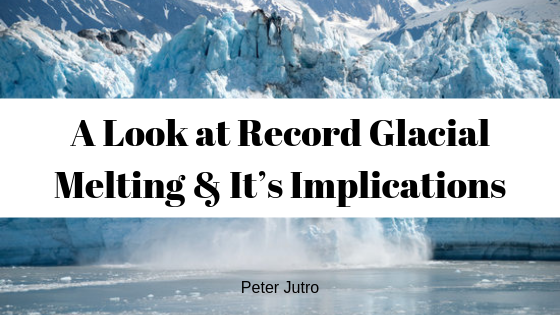Climate change, polar vortex, global warming — these terms appear more and more frequently in the news and on social media, often relating to the melting of glacial ice in Antarctica, Greenland, and mountain ranges around the world. According to the National Snow & Ice Data Center, 10% of the Earth is covered in ice, including polar ice caps, glaciers, and ice sheets located in Antarctica and Greenland. Some may confuse glacial ice and sea ice since glacial ice can be found in the ocean. Sea ice forms in the ocean, whereas glacial ice forms on land. Icebergs are not sea ice but are large pieces of ice that have broken off glaciers and have floated away into the ocean. Glaciers are compacted ice that formed from fallen snow over a long period of time. Glacial ice becomes thick and dense enough to begin moving and form into continental ice sheets or alpine (ice “flowing” downhill) glaciers. The largest glacier in the world is Antarctica’s Lambert-Fisher glacier, which is 250 miles long and 60 miles wide. The biggest US is Alaska’s Bering glacier.
Why should we worry about melting glacial ice? The extent of glacial ice has been changing – shrinking and growing – since the end of the last ice age, but it is only in the 20th century that scientists began to catalog detailed global data gleaned from satellite images. In the past 25 years, a study has shown that Antarctica’s Pine Island and Thwaites glaciers are losing ice five times faster than they were in the 1990s. In the 1850s, Glacier National Park had some 150 glaciers. The park is now down to about 25 active glaciers. Major media are taking notice. According to scientific studies reported by CNN, Greenland lost 11 tons of ice in just one day this summer and lost 197 billion tons of ice in July. Almost universally, scientists place the blame on climate change. Warmer air and ocean temperatures are melting the glaciers as well as affecting weather patterns.
Glacial melting has ripple effects. As more ice melts, sea levels rise, resulting in greater coastal flooding, erosion, and higher storm surges. The insurance industry is struggling to find ways to deal with potential catastrophic monetary losses other than simply by raising premiums. As mountain glaciers shrink, many areas find their water supplies threatened, as they depend on a predictable amount of glacial meltwater. California is facing this problem, as are the countries that depend on water flowing from Himalayan glaciers. The fishing industry will be affected since warm ocean temperatures and changes in salinity alter the behavior of fish. Much wildlife is absolutely dependent on non-glacial ice, including walrus and polar bears.
We have lost a great amount of glacial ice in the past 25 years alone. The challenge is still to find effective ways to mitigate climate change and thus slow down the melting.

